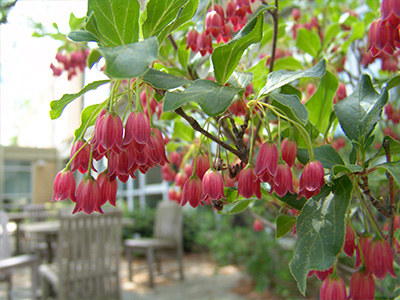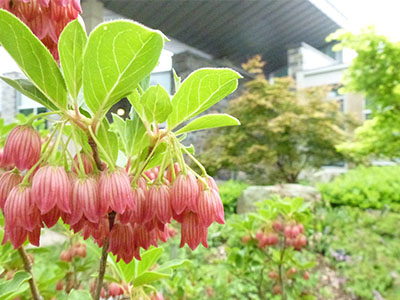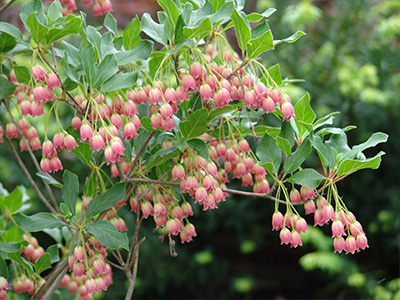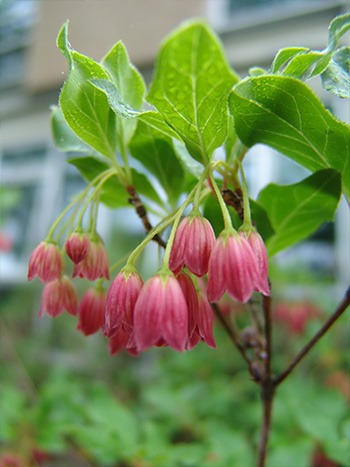Enkianthus campanulatus (redvein enkianthus)
The genus Enkianthus was first described by 18th century Portuguese naturalist João de Loureiro in the publication of his work “Flora Cochinchinensis”. Coming from the Greek “énkyos” and “anthus” it literally translates to “pregnant flower,” likely from the inflated, fused corollas found on some (but not all) species. It is a genus of small shrubs and trees in the family Ericaceae (closely related to Rhododendron), and is prevalent in open woodlands from the eastern Himalayas, south into Vietnam, and as far northeast as Japan. Some sources say that, “cladistically, Enkianthus is considered the most basal genus of Ericaceae,” meaning that the common ancestor shared by both Enkianthus and the rest of the Heath family was the first to split off, evolutionarily.

The species Enkianthus campanulatus, commonly known as the “redvein enkianthus,” (or more colloquially yet: “furin-tsutsuji”), was first brought to the Western world by Charles Maries, the 19th century English botanist and collector. Photo Credit: R. Robert

The species’ flowers emerge off-white with red veins, but many cultivars exist with flowers tending toward full red corollas. Photo Credit: J. Bickel
The species Enkianthus campanulatus, commonly known as the “redvein enkianthus,” (or more colloquially yet: “furin-tsutsuji”), was first brought to the Western world by Charles Maries, the 19th century English botanist and collector, from a plant collecting trip in Japan for Veitch Nurseries of England. The specific epithet comes from the Latin descriptor for a bell-shaped object and denotes the pendulous corollas. The species’ flowers emerge off-white with red veins, but many cultivars exist with flowers tending toward full red corollas. The fall color, bright red, yellow, or orange, is also of interest.

Some nice specimens, representing a fraction of the available cultivars, can be found at the Scott Arboretum in the Terry Shane Teaching Garden, The Meetinghouse Woods, and The Harry Wood Garden. Photo Credit: R. Robert
There are many varieties and cultivars of E. campanulatus available on the market. Some boast deeper reds or pinks in the flowers, e.g., ‘Showy Lantern’, which tends to have a denser flowering habit; var. sikokiantus with maroon flower buds; fast growing ‘Miyama Beni’; or var. palibinii with more delicate red venation. Other cultivars demonstrate interesting gradients on the flowers, e.g., ‘Red Bells’ with yellowish flowers fading to deep red toward the tips of the petals; ‘Lipstick’ with a white to hot pink gradient; ‘Renoir’ with yellowish flowers grading to pink tips. Then there are the cultivated oddities, e.g., ‘Venus’ with extra-large flowers; ‘Hollandia Red’ and ‘Wallaby’ with dwarf growing habits; and ‘Albiflorus’ with pure white flowers that lack the typical red venation. Some nice specimens, representing a fraction of the available cultivars, can be found at the Scott Arboretum in the Terry Shane Teaching Garden, The Meetinghouse Woods, and The Harry Wood Garden.






No Comments